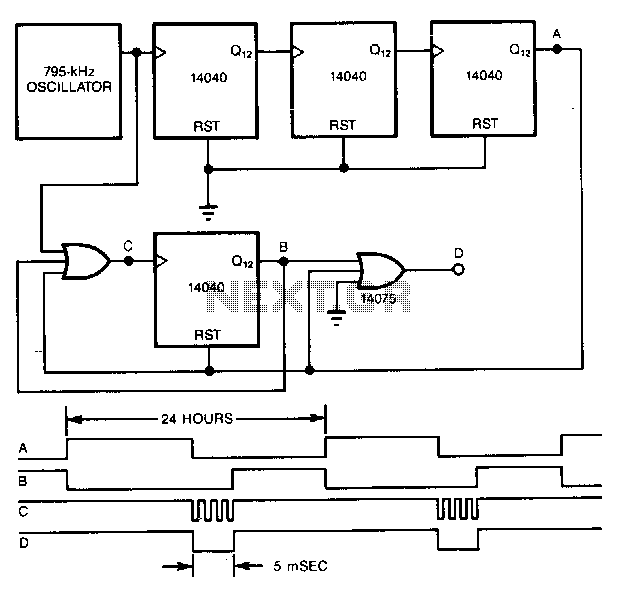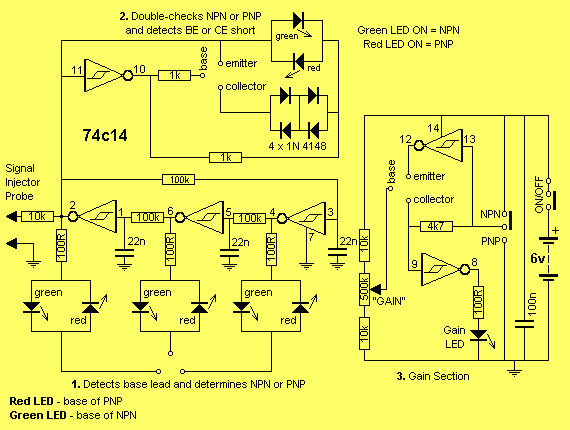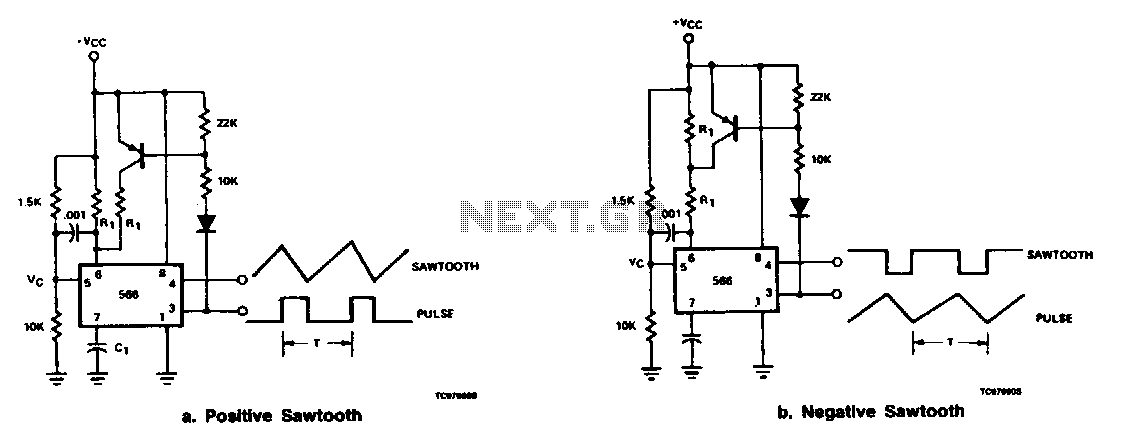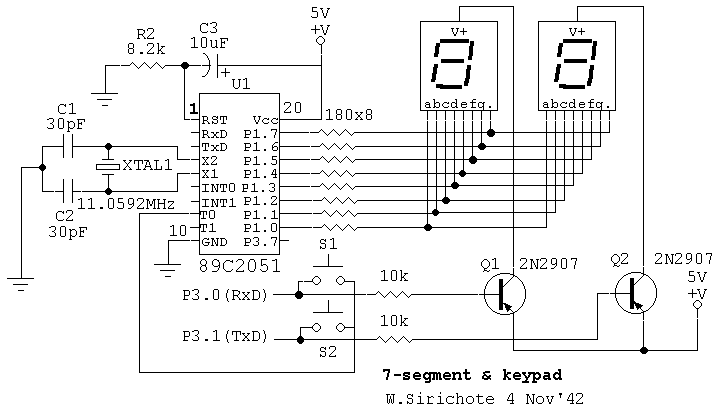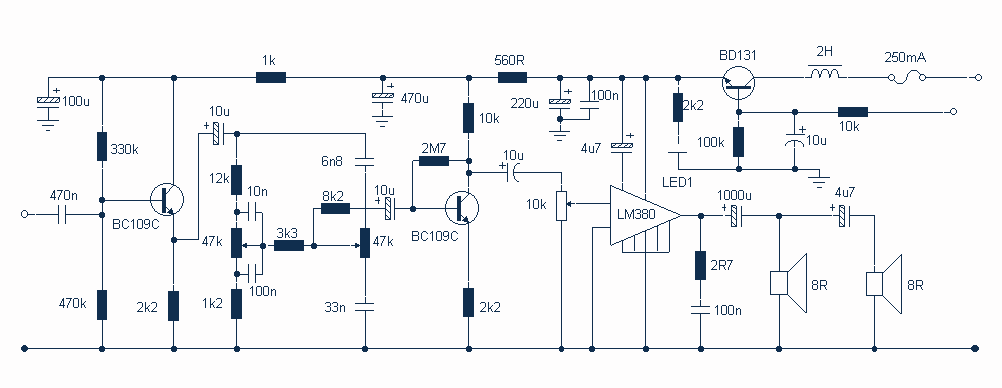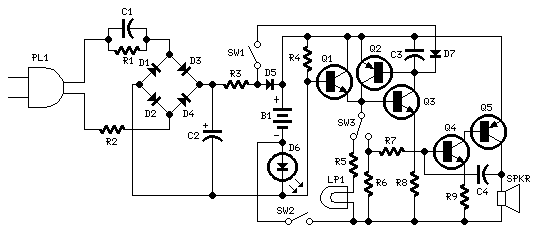
Pulse-Generator & Signal-Tracer
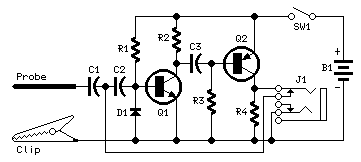
This simple circuit generates narrow pulses at about 700-800Hz frequency. The pulses, containing harmonics up to the MHz region, can be injected into audio or radio-frequency stages of amplifiers, receivers and the like for testing purposes. A high-pitched tone can be heard from the speaker of the device under test when all is working properly. The clip must be connected to the ground of the device under test, touching with the probe the different stages of the circuit, starting from the last stage and going up towards the first.
The described circuit functions as a pulse generator, specifically designed to produce narrow pulses at a frequency range of 700-800 Hz. This frequency is suitable for various testing applications in audio and radio-frequency domains. The output pulses are rich in harmonics, extending into the MHz range, which enhances the circuit's capability to stimulate various stages of amplifiers and receivers effectively.
The circuit typically utilizes a timer IC, such as the 555 timer, configured in astable mode to generate the desired pulse frequency. The frequency can be adjusted by varying the resistor and capacitor values connected to the timer. The output pin of the timer drives a transistor or a MOSFET to amplify the pulse signal, ensuring that it can adequately drive the input stages of the device under test.
For testing, a clip is used to connect the circuit to the ground of the device under test, providing a common reference point. The probe is then used to inject the pulse signal into different stages of the circuit, starting from the output stage and moving towards the input stage. This method allows for systematic testing and troubleshooting of the device, as any deviation in expected performance can be traced back through the circuit stages.
When the circuit operates correctly, a high-pitched tone is audible from the speaker of the device under test, indicating that the injected pulses are being processed correctly. This feedback is crucial for verifying the integrity of the circuit under test and ensuring that it is functioning as intended. Proper precautions should be taken to ensure that the circuit does not exceed the input ratings of the device under test to avoid damage.This simple circuit generates narrow pulses at about 700-800Hz frequency. The pulses, containing harmonics up to the MHz region, can be injected into audio or radio-frequency stages of amplifiers, receivers and the like for testing purposes. A high-pitched tone can be heard from the speaker of the device under test when all is working properly.
The clip must be connected to the ground of the device under test, touching with the probe the different stages of the circuit, starting from the last stage and going up towards the first. 🔗 External reference
The described circuit functions as a pulse generator, specifically designed to produce narrow pulses at a frequency range of 700-800 Hz. This frequency is suitable for various testing applications in audio and radio-frequency domains. The output pulses are rich in harmonics, extending into the MHz range, which enhances the circuit's capability to stimulate various stages of amplifiers and receivers effectively.
The circuit typically utilizes a timer IC, such as the 555 timer, configured in astable mode to generate the desired pulse frequency. The frequency can be adjusted by varying the resistor and capacitor values connected to the timer. The output pin of the timer drives a transistor or a MOSFET to amplify the pulse signal, ensuring that it can adequately drive the input stages of the device under test.
For testing, a clip is used to connect the circuit to the ground of the device under test, providing a common reference point. The probe is then used to inject the pulse signal into different stages of the circuit, starting from the output stage and moving towards the input stage. This method allows for systematic testing and troubleshooting of the device, as any deviation in expected performance can be traced back through the circuit stages.
When the circuit operates correctly, a high-pitched tone is audible from the speaker of the device under test, indicating that the injected pulses are being processed correctly. This feedback is crucial for verifying the integrity of the circuit under test and ensuring that it is functioning as intended. Proper precautions should be taken to ensure that the circuit does not exceed the input ratings of the device under test to avoid damage.This simple circuit generates narrow pulses at about 700-800Hz frequency. The pulses, containing harmonics up to the MHz region, can be injected into audio or radio-frequency stages of amplifiers, receivers and the like for testing purposes. A high-pitched tone can be heard from the speaker of the device under test when all is working properly.
The clip must be connected to the ground of the device under test, touching with the probe the different stages of the circuit, starting from the last stage and going up towards the first. 🔗 External reference
